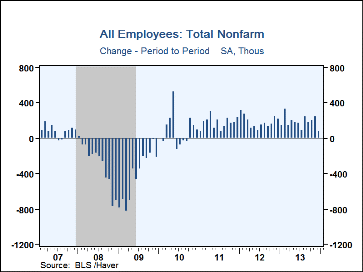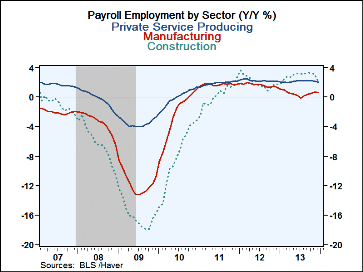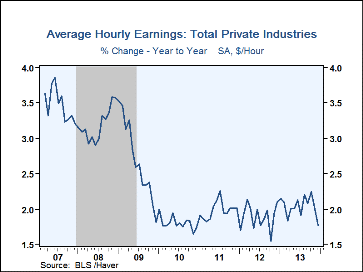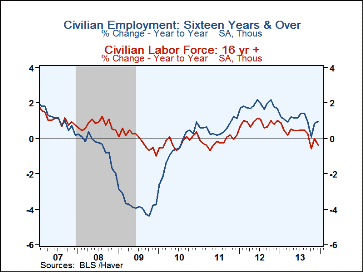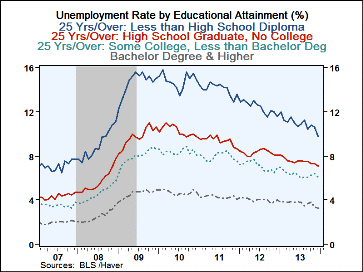 Global| Jan 10 2014
Global| Jan 10 2014U.S. Payroll Employment Gain Disappoints; Jobless Rate Falls to Lowest Since 2008
by:Tom Moeller
|in:Economy in Brief
Summary
Weather may have been a factor, but nonfarm payroll employment growth of 74,000 (1.6% y/y) during December was well short of gains of 241,000 and 200,000 during the prior two months. The rise disappointed consensus expectations for [...]
Weather may have been a factor, but nonfarm payroll employment growth of 74,000 (1.6% y/y) during December was well short of gains of 241,000 and 200,000 during the prior two months. The rise disappointed consensus expectations for growth of 196,000. The unemployment rate fell to 6.7%, the lowest level since October 2008. Expectations were for 7.0%. The total jobless rate, including workers who are marginally attached and part-time for economic reasons, held steady at 13.1%, the lowest level since November 2008.
Nonfarm payrolls increased just 74,000 last month (1.6% y/y) following a 241,000 November increase, revised from 203,000. October's gain of 200,000 was left unchanged. Payrolls in the construction sector fell 16,000 (+2.2% y/y), the first decline since May. Factory sector payrolls also posted a weak 9,000 increase (0.6% y/y), the slimmest in three months. A modest 90,000 increase (2.1% y/y) in private service producing payrolls was its weakest since June 2012. It reflected a soft 19,000 gain (3.5% y/y) in professional & business services, the smallest increase since September 2012. There was a 40,400 increase (9.6% y/y) in temporary help positions and a 12,000 decline (-0.1% y/y) in information services. Transportation & warehousing payrolls showed a minimal decline (+0.9% y/y) and there was no change in education & health services (1.6% y/y) jobs. Leisure & hospitality employment posted a slim 9,000 gain (2.8% y/y). To the upside was a 55,300 increase (2.5% y/y) in retail trade employment. Government sector payrolls fell another 13,000 (-0.1% y/y) reflecting a 9,000 drop (+0.3% y/y) in local government jobs, a 2,000 shortfall (-2.8% y/y) in federal government employment and a 2,000 decline (+0.2% y/y) in state government hiring.
The length of the average workweek shortened to 34.4 hours and reversed its November rise. Private service producing hours fell to 33.2, the shortest since October 2012. The construction sector workweek fell to 38.8 hours, equaling the shortest since October 2012 but the factory sector workweek held at its high of 41.0 hours. Aggregate hours worked in the private sector gained 1.9% (AR) last quarter, roughly double the Q3 rise.
Average hourly earnings ticked up 0.1% last month (1.8% y/y) reflecting a 0.1% rise (1.7% y/y) in private services. That twelve-month gain was down, however, from the full-year average of 2.1%. Construction sector earnings jumped 0.5% (1.5% y/y) and factory sector earnings increased 0.2% (2.4% y/y).
From the household survey, the unemployment rate plunged to a five-year low of 6.7%. The decline occurred as 347,000 (-0.4% y/y) individuals left the labor force and employment rose 143,000 (1.0% y/y). The labor force participation rate fell to another low of 62.8%, its least since 1978. The employment-to-population rate remained low at 58.6%. For men it was a postwar low of 69.1% and for women it was 56.9%. The number of individuals not in the labor force rose a strong 3.3% y/y. The number of individuals not in the labor force but who want a job fell 9.1% y/y and remained near the lowest level since mid-2010. The average duration of unemployment held at 37.1 weeks, down from the 2012 high of 40.3 weeks.
Education continues to pay off. The unemployment rate for individuals with less than a high school diploma was 9.8% and employment was down 1.4% y/y. For high school graduates but with no college the rate was 7.1% and jobs were unchanged y/y. For those with some college but without a degree the unemployment rate was 6.1% but jobs slipped 0.3% y/y. For college graduates the unemployment rate was 3.3% and employment rose 2.5% y/y.
The figures referenced above are available in Haver's USECON database. Additional detail can be found in the LABOR and in the EMPL databases. The expectation figures are from Action Economics and are in the AS1REPNA database.
| Employment: (M/M Chg., 000s) | Dec | Nov | Oct | Y/Y | 2013 | 2012 | 2011 |
|---|---|---|---|---|---|---|---|
| Payroll Employment | 74 | 241 | 200 | 1.6% | 1.6% | 1.7% | 1.2% |
| Previous | -- | 203 | 200 | -- | -- | -- | -- |
| Manufacturing | 9 | 31 | 17 | 0.6 | 0.5 | 1.7 | 1.7 |
| Construction | -16 | 19 | 8 | 2.1 | 2.9 | 2.0 | 0.3 |
| Private Service Producing | 90 | 175 | 187 | 2.1 | 2.1 | 2.2 | 1.9 |
| Government | -13 | 15 | -17 | -0.1 | -0.3 | -0.8 | -1.8 |
| Average Weekly Hours - Private Sector | 34.4 | 34.5 | 34.4 | 34.5 (Dec'12) |
34.5 | 34.4 | 34.4 |
| Average Private Sector Hourly Earnings (%) | 0.1 | 0.2 | 0.1 | 2.1 | 2.0 | 1.5 | 2.0 |
| Unemployment Rate (%) | 6.7 | 7.0 | 7.2 | 7.9 (Dec'12) |
7.4 | 8.1 | 8.9 |
Tom Moeller
AuthorMore in Author Profile »Prior to joining Haver Analytics in 2000, Mr. Moeller worked as the Economist at Chancellor Capital Management from 1985 to 1999. There, he developed comprehensive economic forecasts and interpreted economic data for equity and fixed income portfolio managers. Also at Chancellor, Mr. Moeller worked as an equity analyst and was responsible for researching and rating companies in the economically sensitive automobile and housing industries for investment in Chancellor’s equity portfolio. Prior to joining Chancellor, Mr. Moeller was an Economist at Citibank from 1979 to 1984. He also analyzed pricing behavior in the metals industry for the Council on Wage and Price Stability in Washington, D.C. In 1999, Mr. Moeller received the award for most accurate forecast from the Forecasters' Club of New York. From 1990 to 1992 he was President of the New York Association for Business Economists. Mr. Moeller earned an M.B.A. in Finance from Fordham University, where he graduated in 1987. He holds a Bachelor of Arts in Economics from George Washington University.


